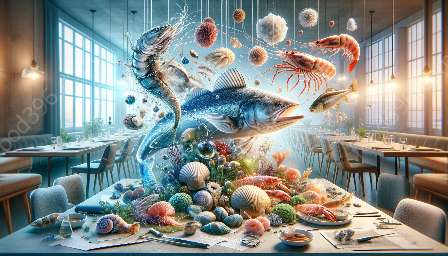Seafood safety and quality control measures are crucial aspects of maintaining the health and well-being of consumers. By understanding the biology, physiology, and science of seafood, we can implement effective measures to ensure the high quality and safety of the seafood we consume.
Biology and Physiology of Seafood
Seafood encompasses a wide variety of organisms, including fish, shellfish, and other aquatic animals. Understanding the biology and physiology of these organisms is essential for implementing effective safety and quality control measures.
One key aspect of the biology of seafood is how these organisms accumulate toxins and contaminants from their environment. For example, fish can accumulate mercury from polluted waters, while shellfish can contain harmful algal toxins. By understanding the biological processes involved, we can develop measures to minimize the accumulation of these harmful substances.
Additionally, the physiology of seafood organisms plays a role in determining their quality and safety. For example, the freshness of fish can be assessed based on indicators such as gill color, eye clarity, and odor. Understanding the physiological changes that occur in seafood after harvesting is essential for maintaining quality throughout the supply chain.
Seafood Science
Seafood science encompasses various disciplines, including food safety, microbiology, and chemistry, all of which are essential for ensuring the safety and quality of seafood products.
Microbiological testing is a critical aspect of seafood safety measures. By examining seafood for the presence of harmful bacteria, parasites, and viruses, we can prevent the spread of foodborne illnesses. Understanding the microbiological processes that occur in seafood, such as spoilage and pathogen growth, allows us to develop effective control measures.
Chemical analysis is another important component of seafood science. Monitoring seafood for contaminants such as heavy metals, pesticides, and toxins ensures that only safe products reach consumers. By utilizing advanced analytical techniques, we can detect trace levels of contaminants and take appropriate action to mitigate risks.
Seafood Safety and Quality Control Measures
Based on an understanding of the biology, physiology, and science of seafood, various measures can be implemented to ensure the safety and quality of seafood products.
Harvesting and Handling Practices
Proper handling of seafood begins at the source, whether it is wild-caught or farm-raised. Sustainable and responsible fishing practices help to minimize environmental impact and maintain the health of seafood populations. Additionally, prompt chilling and storage of seafood after harvesting helps to preserve freshness and minimize bacterial growth.
Regulatory Standards and Testing
Regulatory agencies establish standards and protocols for seafood safety, including testing for contaminants and pathogens. This may involve sampling and analysis of seafood products at various points in the supply chain to ensure compliance with safety standards.
Supply Chain Traceability
Traceability measures, such as labeling and documentation, enable the tracking of seafood products from the point of harvest to the point of sale. This transparency in the supply chain allows for rapid identification and recall of potentially unsafe products.
Processing and Packaging Controls
During processing, seafood undergoes various treatments such as freezing, canning, and smoking. Quality control measures ensure that these processes are carried out under sanitary conditions and that the resulting products are safe for consumption.
Education and Consumer Awareness
Consumer education about seafood safety and quality is vital for promoting informed choices and safe handling practices. By raising awareness about potential risks and best practices, consumers can make informed decisions when purchasing and preparing seafood.
Conclusion
Seafood safety and quality control measures are essential for safeguarding public health and ensuring the enjoyment of high-quality seafood products. By integrating knowledge of the biology, physiology, and science of seafood, we can develop and implement effective measures at every stage of the supply chain, from harvesting to consumption.

